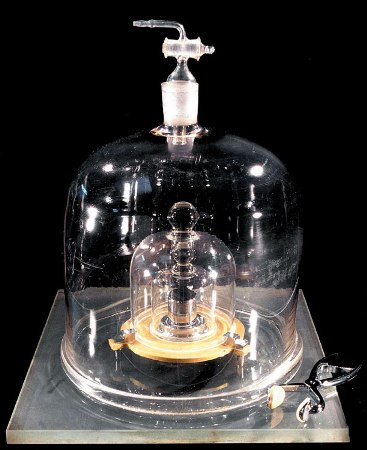
By Tushna Commissariat
I know that many Physics World readers want to be up to speed when it comes to the delicate matter of redefining the kilogram using Planck’s constant (h). You will therefore be pleased to learn that a paper published today in the journal Metrologia has a detailed description of using a device known as a “watt balance” to achieve an accurate value for h with the required level of certainty in the near future.
The international definition of the kilogram is currently based on a lump of platinum–iridium housed by our metrologist friends at the International Bureau of Weights and Measures (BIPM) in Paris. These guys aim to provide the basis for a single, coherent system of measurements throughout the world, traceable to the International System of Units (SI). But, unfortunately, periodic inspections of the lump – known as the International Prototype of the Kilogram (image on the right, courtesy BIPM) shows that it has been losing some of its mass slowly over time, because of chemical interactions between its surface and the air, making it rather unstable and, hence, not the ideal marker for a standard.
The SI is the most widely used system of measurement for commerce and science, and comprises of seven base units: metre, kilogram, second, kelvin, ampere, mole and candela. To ensure that all these values remain stable over time and can be universally reproducible, they should ideally be based on fundamental constants of nature. The kilogram, however, is the only unit still defined by a physical artefact.
What a watt balance can do is to provide a way of redefining the kilogram in terms of Planck’s constant, which relates the frequency of a photon to its energy. First proposed by Brian Kibble at the UK’s National Physical Laboratory (NPL) in 1975, the watt balance relates electrical power to mechanical power. By applying two quantum-mechanical effects – the Josephson effect and the quantum Hall effect – electrical power can be measured in terms of h.
Last October, delegates to the General Conference on Weights and Measures (CGPM) agreed that the kilogram should be redefined in terms of h; but they stipulated that a final decision would only be made when there is sufficient consistent and accurate data to agree on an accepted value for h.
The Metrologia paper describes what needs to be done to achieve the required level of precision above five parts in 108. It provides a measured value of h and extensive analysis of possible uncertainties that can arise during experimentation. Although these results alone are not enough, consistent results from other measurement institutes using the techniques and technology described in this paper will provide an even more accurate consensus value and a change to the way the world measures mass – possibly as soon as 2014.
In the paper, author Ian Robinson from NPL details the work that the lab carried out from 2007 to 2009, including the many in-depth alterations that Robinson made to the device itself as well as trying to weed out uncertainties and achieve the most accurate value. While NPL’s watt balance is currently being used at the National Research Council in Canada, Robinson is sure that it will give considerably greater accuracy and will provide an accurate h within the next two years.
Currently the lowest uncertainty for an h value – at 36 parts in 109 – has been achieved by scientists at the National Institute for Standards and Technology in the US, who have their own watt balance. The BIPM has asked for at least one experiment to achieve an uncertainty of 2 parts in 108, while the other experiments must have an agreement of a value with an uncertainty of 5 parts in 108 before it will allow the kilogram to be defined by h.
When I spoke to Robinson, he said that the NPL watt balance, now in its new home in Canada, is primed to take the most accurate readings. “Over the past six years or so, I have made innumerable changes to the apparatus; each part has been custom-built by Kibble and I, and all of this is explained in detail in the paper. All over the world, people are working very hard to find out where the discrepancies occur,” he says. This means that a consensus should be reached soon.
To find out more about the changes to the apparatus, the series of measurements using different weights and the unexpected uncertainty that cropped up in Robinson’s experiment just as he was poise to achieve the same uncertainty level as the NIST value and the cause for the discrepancy, take a look at Robinson’s paper at this link.
To learn more about redefining the kilogram, take a look at this Physics World blog, feature and video.



